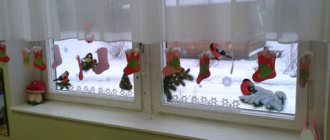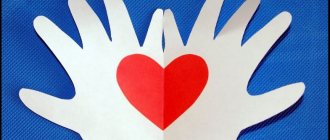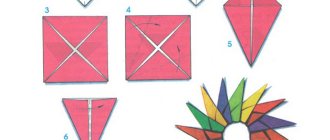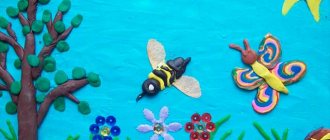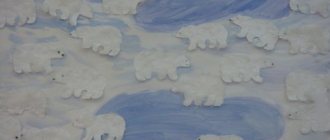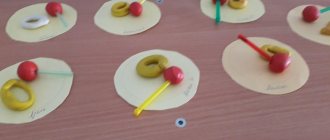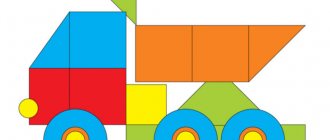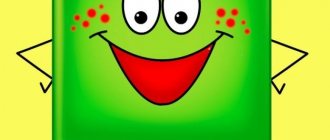Summary of a lesson on appliqué in the junior group “Our Family Album”
Junior group. GCD. Application
Topic: “OUR FAMILY ALBUM. MULTI-COLORED LIGHTS IN HOUSES” (“Comprehensive thematic classes..”, p. 103) (integration of the following areas: “Cognition” (formation of a holistic picture of the world), “Communication”, “Artistic creativity” (application), “Socialization” )
Tasks.
Correctional and educational: to form ideas about the family and one’s place in it; encourage you to name family members and their occupation; learn to paste an image of a round shape, specify the name of the shape, alternate circles by color; consolidate knowledge of colors (red, yellow, blue).
Corrective and developmental. Develop a sense of color, shape and composition. Carry out constant monitoring of the development of correct posture. To develop aesthetic perception in children, to evoke a feeling of joy from their beautifully executed images.
Correctional - educational... to foster independence, the desire to take care of family and friends. Cultivate accuracy in work
Vocabulary: activate the words in children’s speech: red, yellow, blue, mom, dad, grandma, grandpa, family, spread, stick.
Material: Katya doll, photo album with family photographs of children, items that belong to the children’s loved ones; circles of different colors (red, yellow, blue, blue), cut out of colored paper; drawings of houses with large windows (for each child), pasted onto sheets of white paper; glue, brushes, napkins.
Contents of GCD.
1. Organizational moment.
Children, together with the teacher, look at the photo album “My Family” with family photographs of the children in the group. The doll Katya “enters” the group and “greets” the guys.
1 Conversation with the doll Katya. Children's stories about their families.
The teacher invites the children to ask the Katya doll about her family and ask them to tell them who she lives with. The Katya doll “names” her family members and their occupation. Children find photographs of their loved ones in a photo album, show them to the doll and say their names. (In the photo is my mother, her name is Maria. This is my dad, his name is Andrey. Etc.)
The teacher leads the children to understand that mom, dad, daughter, son are a family, that families are small and large, asks each child to remember and determine what kind of family he has - small or large, to name all family members by name. For example: “We have a big family: mom Tanya, dad Kolya, me Sveta, brother Oleg, grandmother Nina and grandfather Seryozha.”
“We have a small family: mom Irina, dad Sasha and me, Denis.” Children tell what their loved ones do.
3. Game “Whose things?”
Objects brought by children from home are laid out on the table: beads, glasses, balls, books, napkins, etc. At the teacher’s signal, “find your grandmother’s things; find your dad’s things…” the children come to the table and look for them. The winner is the one who quickly and correctly found the belongings of his family members.
4.Applique.
Educator. When the day ends, what begins? (Children's answers.) In the evening, all families gather at home. With the onset of darkness, lights come on in the windows of houses. Night has also fallen on our applications; we need to light the lights in the windows of the houses. (Shows how to glue the circles (“lights”) to the windows.) What do the lights look like? (Into circles.) What color? (Children name the colors: red, (yellow, green, blue.)
The teacher makes sure that the lights alternate in color. Children glue mugs to the windows of houses. At the end of the lesson everyone shows their work.
Educator. The day is over, evening has come, the lights come on in the houses, they shimmer in the windows in different colors.
5. Reflection.
What did we talk about today? What was depicted on the applique? What game did you play?
Lesson summary on the topic “Family”. Second junior group
Abstract of GCD in the second junior group on the topic “Family”
Goal: development of skills and drawing techniques. Objectives: Educational:
- To form in children an idea of family, to consolidate the ability to name members of their family.
— Teach children to draw round objects with a felt-tip pen. - Reinforce the name of mother in baby animals. — Reinforce the words “family” and “caring” in children’s speech. Developmental:
- Develop children's coherent speech, fine motor skills of the fingers, the ability to correlate the movements of the arms and legs in accordance with the text.
Educational:
- Cultivate a caring attitude towards family members.
- Induce joy and pride in children that they have a family. Methods and techniques: conversation, play, showing, explanation, examination. Materials and equipment: - Picture “Hen and chicks”.
— Portraits A-4 moms, dads. — Landscape sheets of white paper with a cat, a cat, or two kittens drawn on them for children. Paints. - Easel. — Audio recording of the children's song “The hen went out for a walk...” — Color illustrations depicting animals and their cubs: a fox with her cubs, a hare with her cubs, a she-wolf with her cubs, a she-bear with her cubs, a dog with puppies, a cat with kittens. GCD move
I. Conversation about family - Guys, you all have a family too. Who lives in your family? Sasha, who lives in your family? And in yours, Ira? (Answers from 3-4 children). — Listen to the poem: There are many mothers in the world, Children love them with all their hearts. There is only one mother, she is dearer to me than anyone else. Who is she? I will answer, “This is my mommy!” - Who are these poems about? (About mom). - Who wants to talk about their mother? Come here. A portrait of my mother is displayed on an easel. - How is your mother's name? What is she doing at home? Ask 2 - 3 children. - Why do you think your mother prepares food for you, buys you beautiful clothes, toys, and plays with you? (Because she loves us, takes care of us). - Now say the best words about your mother. What is your mother like? (Kind, beautiful, affectionate...). - Well done guys, you spoke very well about your mother. Listen to my riddle. Who is it about? Who is the most tender in the world? Who's cooking us lunch? And who do children love so much? And who is more beautiful? Who reads books at night? Doesn't he scold my brother and I? Who is this? Our mother). Physical education minute. In an even circle, one after another, we go step by step. Stand still, together, let's do everything like this! - Now listen to one more riddle : Who will teach us how to hammer a nail, not as a joke, but seriously? Who will teach you to be brave? If you fall from a height, don’t you whine? And if you scratch your knee, don’t cry. Of course... (dad). - Let's talk about dad. Who wants to talk about dad? A portrait of the pope is displayed on an easel. — Sasha, what’s your dad’s name? What is he doing at home? How does it help mom? - Masha, tell me about your dad. Ask 2-3 children - Mom and dad love you, take care of you. How do you help mom and dad? (Children's answers) - I liked the way you talked about your family. Your parents take care of you, and you help them. - Let's play with you. Finger game “Family” This finger is grandpa, This finger is grandma, This finger is daddy, This finger is mommy, This finger is me. That's my whole family. 2. Drawing “Globules”. - Now let's play another game. You all have a mother. What are animals' mothers called? The game is played using illustrations. For rabbits, their mother is a hare For fox cubs - a fox, for wolf cubs - a she-wolf For bear cubs - a she-bear For puppies - a dog For kittens - a cat. -Who is the kittens’ dad? (Cat). - Here they are! A landscape drawing sheet with a picture of a cat, cat and kittens is shown.
- This is a friendly family.
Look at the kittens? (Cheerful). Let's draw balls for them. Notice how I hold the brush and start painting. Showing how to draw balls on a board.
- I will stretch the thread from the ball to the kitten.
Using another felt-tip pen, draw a ball for the second kitten. I will stretch the thread to his paws. Take the brush correctly in your right hand, hold a sheet of paper with your left hand, put a dot and start drawing balls. Place children's drawings on a separate table.
— Guys, let's look at your work.
Misha, what color are your balls? Look, here one ball is larger, and the second is smaller. And here the kitten played so happily with the ball that the threads got tangled. Well done! Reflection - Guys, today we talked about family. You all have a dad and a mom who love you very much and take care of you. And you also help your parents. I liked the way you talked about your family, solved riddles, played, and drew. Well done!
We recommend watching:
GCD summary in the 2nd junior group on the topic “Friends for the Snowman” GCD summary for mathematical development in the first junior group GCD summary for the first junior group on the development of mathematical abilities using ICT Summary of GCD for the development of creative abilities for children of the first junior group
Similar articles:
Summary of educational activities for children of the younger group “Visiting the Fox”
Summary of the integrated lesson “The Adventures of Kolobok” in the junior group
Lesson on familiarization with the environment and development of speech “My Family”
Author of the lesson: Fedorenko Vitalia, Ust-Kamenogorsk, kindergarten “Bolashak”.
Purpose of the lesson:
Help children understand family relationships.
Tasks:
1. Educational: to form children’s ideas about family members and those who live in it.2. Developmental: development of fine motor skills, vocabulary work: little finger, ring finger, middle finger, index finger, thumb, daddy, daddy, Uglichan.
3. Educational: to cultivate interest and respect for family members and the city.
Preliminary work:
We looked at photographs of the family, learned to name all members of our family by name and relationship (who is related to whom). Children and their parents drew pictures on the theme “My Family.” The children made blanks (a layer of plasticine was applied to the cardboard). Reading fiction about family.
Materials and equipment:
Flannelgraph, images of houses, “tree palms”, cardboard blanks with a layer of plasticine, peas, photographs (faces) of mother, father, grandfather, grandmother and child.
Progress:
Educator:
Today we will go on a journey. What can you go on a trip with? (by car, plane, rocket, boat, ship)
Educator:
But you and I will not fly, we will not ride or sail, but we will gallop. They jumped on one leg.
Educator:
Look, we have galloped into the city with you. Stand on the path, straighten your legs.
Etude:
What a miracle, miracles (we show our palms) One hand and two hands. Here is the right palm, Here is the left palm. And I’ll tell you, you don’t have the same hands. Everyone needs friends. Kind hands pet a dog, Clever hands know how to sculpt,
Sensitive hands know how to make friends.
In our city they also know how to make friends.
Educator:
(on the flannelgraph there are one-story and multi-story houses, trees in the shape of a palm) - What is there in our city? (houses, trees) - What kind of houses? (multi-story, single-story) - What else is there in the city? (trees) - What do trees look like? (on palms)
- Take the wood you like and sit down at the tables.
Educator:
Let's play with our fingers. Clenched your fist.
This finger is grandpa. This finger is grandma. This finger is daddy. This finger is mommy. This finger is me.
That's my whole family.
— What did we talk about when we played? (about family) - Do you have a family? - Who is the youngest in your family? (me) - What is your affectionate name in your family?
- Find your photo and put it on your little finger.
Educator:
My mother and I were making cutlets, and it was raining outside the window. My mother and I were thinking at the same time.
How can we be together well?
- Who is this poem about? (about mom) - Do you feel good with your mom? - What’s your mom’s name? - And as an adult? (surname)
- Find a photo of your mother and place it on your ring finger. Mom is next to you.
Educator:
My dad does not tolerate idleness and boredom. My dad has skillful, strong hands. And if anyone needs help
My dad is always willing to work.
- Who is this poem about? (about dad) - What kind of dad? (strong, brave, kind) - How affectionately can you call dad? (daddy, daddy)
- Find a photo of your dad and put it on your middle finger. Dad is next to mom.
Physical school
Educator:
Get up, we'll rest a little, play with our palms.
Ladushki, ladushki, where grandma had them (claps) And grandma’s palms are all wrinkled (palms up) And grandma’s palms are kind, kind (we stroke our palms) Our palms have worked for many years (we bang our fists on our palms) Good palms smell like cabbage soup, pies (palms to your face and sniff) Kind palms will stroke your curls (we stroke ourselves) And any sadness will be sweetened by kind palms (we bring it to our face and blow)
Okay, okay, where were you at grandma’s (clap)
Have you rested? Take your seats.
Educator:
— What can your grandmother do? (knit, bake pies) - Find a photo of your grandmother and put it on your index finger. - We have one finger left - the thumb. Who is this? (grandfather)
Listen to what poem I know about grandfather.
I have a grandfather Like winter gray, I have a grandfather With a white beard. My grandfather can answer everything for me And my grandfather is not old
At least he is a hundred years old.
- Does grandpa help grandma at home? - How does he take care of you?
- Find a photo of your grandfather and put it on your thumb.
Educator:
Look, you have a big happy family in the palm of your hand. Everyone in the family loves, cares and helps each other. Let's give you a gift. Think for a moment about who you want to give a gift to and what kind (there are blanks on the table - cardboard and plasticine, peas in plates). Children give gifts.
Educator:
Once done, place the gift on the finger to whom you want to give your gift. (We look to whom the child gave a gift). - Take your “palm trees” and place them in our city wherever you want.
Step back and look, all our families are in the city. It's big, beautiful, and everyone is friends there.
Result:
Our journey has now ended. Did you like it? What do you remember most?
Download lesson notes “My Family”
In 1930, the film “The Rogue Song” about the kidnapping of a girl in the Caucasus Mountains was released in America. Actors Stan Laurel, Lawrence Tibbett and Oliver Hardy played local crooks in this film. Surprisingly, these actors are very similar to the heroes...
Read more…
Source: https://vospitatel.com.ua/zaniatia/mir/moya-semya.html
Short-term project “MY FAMILY”
with their own chairs.
D: Children stand next to the chairs.
Q: I will name an action: if this action pleases your loved ones, you
clap your hands, if it upsets you, stomp.
All the toys were scattered around the room;
Helped mom wash the dishes;
Draw and give mom or dad a beautiful drawing;
Helped grandpa find his glasses;
Always say “thank you”, “please”, “hello”, “goodbye” to your family.
Helped grandma bake pies;
Feed the dog or cat;
They ran away from adults;
We learned to dress ourselves, without the help of adults;
Protected a brother or sister from a bully.
I see that you know what actions can upset and please your family. I hope that you will do only good deeds!
Children continue to stand next to the chairs.
Masha: Guys, I really enjoyed visiting you, I’m glad that each of you
I also have my own home and a strong, friendly family! And now it's time for me to go home,
After all, visiting is good, but home is better, my family is waiting for me at home! Before
goodbye!
Q: Goodbye, Masha, come visit us again, the children will show you an album with
family photographs, which we have in the book corner, and
They will tell you a lot more interesting things about their family!
Q: Now let's open our magic box.
Guys, look, a miracle happened: every kind word turned into
in the heart. (V. opens the box and shows hearts made of colored paper.)
Now I will give hearts to you all, and in the evening you will give them to someone
want from your family, don’t forget to remember your kind and kind words! Your family will be very pleased!
APPLICATION
Conversation “My Family”
Goal: Teach kids to take care of their loved ones. Draw children's attention to how adults care for them.
Methodology: During the conversation, the teacher asks the kids the following questions:
— Who lives with you in your family? (Mom, dad, grandmother, grandfather, brother, sister.)
- Who do you think is the eldest in the family? (Grandfather, dad.)
- Who is the youngest in the family? (Me, younger brother, sister.)
— What does mother do in the family? (Cooks, cleans, washes, irons.)
-What does dad do in the family? (Repairs furniture, screws in light bulbs, etc.)
— Where do parents work? (Children's answers.) What are they doing?
— Do your parents take care of you? How do they do it?
Next, the teacher leads the kids to the conclusion that parents love their children very much, take care of them, do everything to make the children feel good, and that the children, in turn, should also take care of their mother and grandmother, help them, notice their mood .
In everyday life, the teacher, at every opportunity, should pay attention to how adults take care of them. For example, noticing that a girl came in a new dress, you can say: “How your mother took care of you, she sewed such a beautiful dress for the holiday! Did you tell your mom “thank you” and kiss her?”
